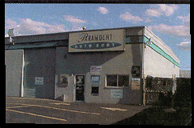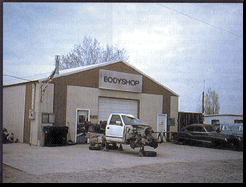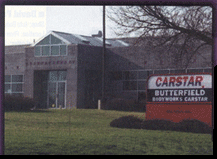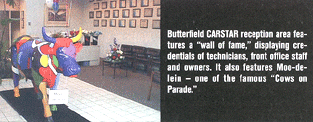Find a mirror, and take a good look. What do you see?

The real you – the honest business person who produces quality work, done right the first time, and who bills only for actual work done, parts purchased and materials used.
Then why is that TV shows such “20/20,” “Dateline” and “60 Minutes” see you so differently? Why does the public think you and your fellow shop owners are a bunch of backalley, unethical corner-cutters who won’t -or can’t – repair a car properly? Why does the public think you’re going to rip them off?

Let’s face it. Overall, our industry image stinks. The thing is, stereotypes come from somewhere.
While clearly in the minority, shops with lousy ethics and morals have built a poor image, and many continue to perpetuate this image through their daily practices. And people who get ripped off tend to speak out louder than people who’ve had their expectations met or exceeded. What happens, then, is that everyone hears the negatives, while the positives fall by the wayside.

So who pays the price? We all do. Each and every one of us. Your employees, your families, your suppliers, insurance companies, schools providing collision repair training … you name it. If it’s affiliated with the collision repair industry, it’s affected one way or another. We pay in terms of lost customers – potential customers who drive beat up autos because they avoid going in for repairs for fear of getting screwed. We also pay in terms of our own self-esteem; many repairers can’t look someone in the eye and say they work in this industry. We pay in terms of our ability to attract people to come to work for us.
We pay, we pay and we pay!
And just when the dust seems to settle, a sensational TV spot focused on our industry comes out, and millions see it, reinforcing their beliefs about the collision industry. It’s not fair, of course. We all know that. The focus of these TV programs is on that small fraction of our industry that perpetrates fraud. Meanwhile, these TV show “Special Reports” don’t show the film footage of the good shops, only the jerks who create more damage that they can bill the insurance company for. They only show the doctored invoices with parts that weren’t actually used or replaced. They only show the bogus airbags that were placed in cars.
In response to this skewed publicity, many industry associations and organizations are doing things to address our industry’s image. The National Auto Body Council (NABC) focuses on nothing but enhancing the collision industry’s image. The NABC’s members do a number of things throughout the year and on a daily basis – from community service to hosting open houses – to help elevate the industry’s image. Shops also can use training, certification, credentials, etc., as leverage to enhance their own image.
What’s all the fuss about, you say? Image isn’t that big of a deal.
Maybe not to you. But it is to the public – and to many of your fellow shop owners. In fact, in a recent informal survey conducted by the NABC, every shop owner indicated that they consider their shop’s image and how the public perceives our industry and, in particular, their own shop. And when ranking the top five issues affecting this industry, they ranked image No. 3.
If image isn’t important to you, it should be.
So what are successful shops doing to address our industry’s image problem? Let’s take a look by examining the NABC’s questions and the answers given by several shop owners who participated in the survey.

Q: What steps have you taken to enhance the exterior of your building to portray a particular image to the public?
Fisher/Naper:
“We keep the grounds clean and attractive in all four seasons – keeping the sidewalks and parking area clear of snow in the winter, mowing and planting in the summer. …”
Boyce/Boyce:
“When we were planning to build our new shop, we knew we wanted to portray a professional image. É We were pleased when our local paper did an article and said this about our building: ‘Featuring a brick facade and an aesthetically creative front lobby, the two-story structure looks more like a trendy office building than an autobody shop.’ ”
Waldren/Paramount:
“The exterior of the building is maintained and painted regularly. The front parking lot is sealed and re-striped yearly, and the outside of the building area is kept immaculate. The back parking lot is striped for organization. Once this was done, the parking lot dings stopped.”
Langton/Blue: “We try to keep it clean. We have no used parts or garbage visible. We also hang ASE and I-CAR signs out front.”
Ryan/ABRA:
” É We have a lawn service and annual shrub and tree trimming. We installed privacy slats in our fence lot area.”
St. Germain/Banner: “We have a well-marked and lighted customer drop-off area. We have professional painted signs on the exterior, signs showing the insurance companies we write for and a parking lot for estimates.”
Q: What steps have you taken to enhance the interior of your building to portray a particular image to the public?
Waldren/Paramount:
“The interior office is decorated in a professional manner, surpassing a physician’s office. The office is cleaned each night and kept clean during working hours. The shop area is very organized and painted on a regular basis.”

Turmel/Collex:
“Each shop has the same interior as the other – blue, white and gray. This color combination makes for a nice, clean look that looks good all the time. At one of our locations, we have a saltwater fish tank in the lobby. This always gets the customers to come and take a look at it. In the drive lane, the floor is gray, making for easy clean up, plus it looks good all the time. We also have a wall of glass so the customers can look at other vehicles being repaired when they drop off or pick up their vehicle.”
Newton/True2Form:
” É We have a changing table for babies and books for children.”
Silver/Butterfield CARSTAR:
“No smoking is a must in our facility. The interior is kept clean and attractive. No parts are visible, and there are no shop odors evident. We also have a large tree in the middle of our lobby.”
Fait/Auto Body World:
“We have an open floor plan, lots of glass and have taken great steps in our interior design (i.e. wallpaper, tile, etc.) We have tall ceilings to increase the feeling of spaciousness and openness.”
Anderson/Wagonwork:
“We’ve painted our walls and hung certificates. We have a cooler where we give free beverages to our customers, wallpaper in our customer restrooms and installed a TV/VCR. Our CSI survey results are posted in nice frames for our customers to view.”
Ryan/ABRA:
“Our shop area is all gloss white with stripes. We have matching cabinets and benches for our techs and keep our parts area well-organized. In the office area, we have consistent furnishings, framed company-related articles and awards, framed DRP plaques and a coffee bar.”

Q: What image are you attempting to portray to the public?
Fisher/Naper:
“A professional image similar to a doctor’s office.”
Newton/True2Form:
“That we’re friendly, caring and accommodating.”
Silver/Butterfield CARSTAR:
“That we’re professional – and proud of this industry.”
Anderson/Wagonwork:
“We want to portray that we’re higher class. We want to be like the Ritz Carlton of body shops, not just in cleanliness but also in service.”
Wano/G.W. Wano:
“We want to portray the image of professionalism. [We’re attempting] to remove the persona of the ‘body shop’ and replace it with ‘repair facility.’ ”
| Bad RapThe National Autobody Council is working to elevate the collision industry’s image and to convince the public that this industry isn’t made up of con men and hackstersThe NABC’s pledge that its members hang on the wall in the reception areas of their shops says it all:
“We are part of an ethical, trustworthy, honorable business within the Collision Industry. We take pride in our professionalism and our ability to serve our customers. We respect the law and the environment. We continue to study our profession and are participants in our community. We are proud to work in this industry.” If everyone in this industry lived by this pledge, we wouldn’t have an image problem, would we? The NABC is also the organization behind Collision Repair Industry PRIDE Month, a month-long celebration in October of each year. PRIDE month celebrates the professionalism that exists in this industry and gives shops a rallying point for open houses, local press releases, etc. State governors across the country have often declared October as PRIDE month. The NABC sends out a nationwide press release to hundreds of local newspapers highlighting what this industry is all about and inviting the public to learn more about it. And it gives participating shops an opportunity to showcase not only their shops, but their integrity as well. |
Q: Have you had an open house and invited the public to see what your shop and today’s collision repair industry is all about?
Fisher/Naper:
“We hosted an open house with a Grand National stock car as the attraction. Our paint company helped with the promotion. We also offer continued education for insurance agents and their staff. They visit our shop, and we educate them on the repair process.”
Waldren/Paramount:
“We celebrated our 25th business anniversary and invited over 600 agents, staff, claims offices, customers, neighbors, friends and suppliers. We wanted to demonstrate how clean and organized our shop is and what should be expected in the industry. It was very well received. É One insurance agent made the comment, ‘Do you see that there are guests eating off the frame racks? Where else can you do that?’ Many guests have asked for us to do it again.”
Turmel/Collex:
“We have monthly car shows in the summer months that the public is invited to. The car shows take place inside and outside of the building. … We also have airbag safety classes that are held in our training classroom. We invite local police, fire and EMS departments. These classes are well-received in the community. Every week, we get a few phone calls [from people asking] when we’re going to have the next airbag safety class.”
Fait/Auto Body World:
“We’ve done grand openings. They were very expensive, we had low exposure and the public didn’t seem to care a lot. We have had good response to our community outreach – we’ve taken our message of being a good citizen into the schools. We’ve sponsored literacy and reading programs that have been well-received, as well as sponsoring recreational sports teams.”
Anderson/Wagonwork:
“We have several open houses a year, ladies clubs, high school Skills USA/VICA students and car clubs such as the Porsche Club, Audi Club, Mercedes Benz Club, etc. … We have our parts distributors give us door prizes, and we have drawings throughout the day. We actually paint a car in our paint booth while [attendees] watch through the window, pull a frame on a frame machine, straighten dents … This is not only good for the consumer, but it’s also good for our employees. It gives them a chance to show off their skills.”
Ryan/ABRA:
“We’ve hosted a BBQ for agents in the area, and hosted an open house for high school students and their parents.”
Q: What are you doing to combat the things that other shops do that feed into the negative stereotype of our industry? What are some of the strategies you’ve taken to enhance your shop’s image or the image of the industry as a whole?
Waldren/Paramount:
“Shops in our area tend to be run down and not well kept. I’ve heard about other owners yelling at their customers. Our business is managed by ethics – we do what we say. Our communication skills with customers are exceptional. We have constant training for our customer service reps as well as our technicians. … Over the past four years, we’ve worked with a consultant regarding communication skills.”
Silver/Butterfield CARSTAR:
“We see some fraudulent and/or unsafe repairs that others have done that we re-repair sometimes with little or no compensation because we can’t let the vehicles go out unsafe. I’m personally very involved in the community and the industry. I give lots of time and share knowledge so that the industry is represented in a positive way. We’re a positive role model in business, community and industry. We preach ethics and pride, and we dress professionally and conduct ourselves in a business-like manner.”
Fait/Auto Body World:
“We’ve all seen shops that feed into the negative, stereotypical image of our industry. No wonder customers have no confidence in our industry. … We’re heavily involved in our local and national associations, preaching the message. We’re working closer with insurers. We’ve worked hard on our own service product to deliver on the promises we make. One car at a time, 12,000 times a year, we try to change customer perceptions by meeting and exceeding expectations. … Someday, as enough shops become serious about customer service, a quality product and honest billing, the perception will shift.”
Langton/Blue: “We send out informational newsletters to customers, have joined trade associations and help with I-CAR training. We’ve also sponsored little league teams and graduation parties. We custom-paint mailboxes and donate them to benefit raffles. We also do estimate follow-up letters and send thank you cards and newsletters.”
Anderson/Wagonwork:
“We have all of our employees wear 8-inch shirt tails so that if they bend over … They all also wear a belt and a uniform. And they can only wear Wagonwork T-shirts in the summer. No other shirts. We’re very big on employee appearance.”
St. Germain/Banner:
“We have meetings with other shop owners and managers to promote our industry. We’re a member of the Louisiana Collision Association that consists of members all over the state. [The association has] hired a lobbyist to help with laws we need to pass and change for the benefit of our industry.”
Q: What steps have you taken with your employees to address the issue of image?
Boyce/Boyce:
“Image issues with employees have to take into account the quality of their work. If they don’t do a good job on our customer’s vehicles, it’s hard to maintain a good image. We’ve tried hard to find quality technicians who take pride in their work. We also request all technicians wear the provided uniforms.”
Waldren/Paramount:
“We provide weekly training to address how they communicate with customers and insurance companies.”
Butterfield CARSTAR:
“We stress professional dress, pride in work, a clean and healthful work environment, and have performance and behavior guidelines.”
Fait/Auto Body World:
“Our employees know that cleanliness, uniforms, professionalism and integrity are very important to us and our image. Every day, we reinforce with our employees the need to keep our promises to the customer and deliver the product we discussed. … To know whether we’re hitting the mark, we attempt to ask every one of our customers how they feel we did. The high point of the survey is when we asked them if they were ‘delighted with our service.’ It’s a powerful force when your employees think it’s important to ‘delight’ the customer.”
Ryan/ABRA:
“We tell our employees not to wear anything with our company logo into bars. All employees have uniforms or logo shirts and ties.”
Wano/G.W. Wano:
“We involve them as much as possible. Some of the work we do is cosmetic maintenance on church and mission vehicles. In many circumstances, they’ve donated their labor toward the cause.”
It took decades for some in this industry to dig the negative stereotypical hole our industry is in. And it only takes a 10-minute, sensationalized TV spot to dig it even deeper. However, one by one, customer by customer, we all must pull in the same direction to start digging ourselves out of it. Follow these examples, blaze trails of your own, join the NABC, host an open house to showcase what you’re all about and set yourself apart from the rest. You can not only change the image of repairers in your community, but help turn around our image nationally.
Writer Mark Claypool is president of Mentors at Work and the executive director of the National Auto Body Council, and was the former executive director of the I-CAR Education Foundation and the former director of development for Skills USA/VICA.
For more information on the National Auto Body Council (NABC), visit www.autobodycouncil.org or call (888) 667-7433.
| Be HonestThe word “fraud” comes up all too often when we see reports about this industry. And oneof the most common cases of fraud is burying deductibles. Customers, often not knowing any better, ask repairers if anything can be done with the deductible. In an effort to secure the business, some shops agree to play around with the numbers.
What exactly is burying a deductible? The Collision Industry Conference (CIC) anti-fraud committee wrote this statement related to it: “Burying a deductible occurs when an estimator or repairer takes the amount of the policyholder’s deductible and ‘hides’ these costs elsewhere in the estimate. This is done at the policyholder’s request in order to avoid paying the deductible, or is offered by a repairer as an inducement to keep the repair work at that particular shop. If a shop conspires to ‘bury the deductible,’ it is committing a fraud upon an insurance company and is against the law in most states.” Explain to customers what burying a deductible really is: fraud. Explain that shops that participate in burying a deductible are committing fraud and that they, as customers, should be wary of this and concerned about what else the shop might be doing in the repair process. Good shops need to distance themselves from those who commit fraud and earn someone’s business by being trustworthy, rather than by lowering standards or breaking the law. |













